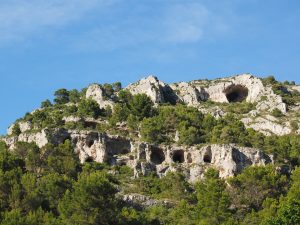Karst phenomena
Some of the rocks forming the Earth’s crust subject to dissolved by water.
These include:
- rock salt
- gypsum
- anhydrite.
The rocks that contain calcium carbonate (limestone, marl, dolomite) are also dissolved, but in the process also involving carbon dioxide.
Generally, the phenomena of dissolving rocks by water is called karst phenomena.
A specific example of karst phenomena occurs in ice (glacial karst, cryokarst). The mechanisms of dissolution of different types of rocks and ice are different from one another, but the common feature of all karst phenomena are form created both on surface and underground.
Karst in carbonate rocks
The rocks containing calcium carbonate (CaCO3) are limestone, marl, dolomite. Rainwater combined with atmospheric carbon dioxide (CO2) forms a weak carbonic acid.
H2O + CO2 → H2CO3
Carbonic acid dissolves rocks carbonate according to the following chemical reaction:
CaCO3 + H2CO3 →Ca(HCO3)2
Washed out in this way, calcium carbonate causing the rocks erosion of karst forms (crèches and ribs, funnels, caves, corridors, chimneys).
The dissolved calcium carbonate may again precipitate to create such forms as:
- stalactites
- stalagmites
- stalagnates
- draperies.



 This project (EDU-ARCTIC) has received funding from the European Union’s Horizon 2020 research and innovation programme under grant agreement No 710240. The content of the website is the sole responsibility of the Consortium and it does not represent the opinion of the European Commission, and the Commission is not responsible for any use that might be made of information contained.
This project (EDU-ARCTIC) has received funding from the European Union’s Horizon 2020 research and innovation programme under grant agreement No 710240. The content of the website is the sole responsibility of the Consortium and it does not represent the opinion of the European Commission, and the Commission is not responsible for any use that might be made of information contained.